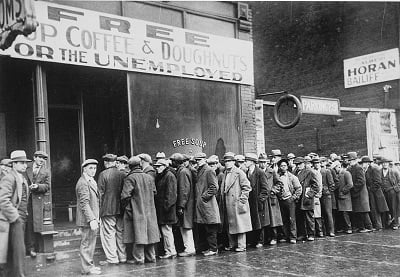A US economic depression that began soon after the stock market crash of October 1929, which sent Wall Street into a panic and wiped out millions of investors. Over the next several years, consumer spending and investment dropped, causing steep declines in industrial output and rising levels of unemployment as failing companies laid off workers. By 1933, when the Great Depression reached its nadir, some 13 to 15 million Americans were unemployed and nearly half of the country’s banks had failed. The economy would not fully turn around until after 1939, when World War II kicked American industry into high gear. Writing in “The United States’ Unresolved Monetary and Political Problems”, William Bryan describes the carefully contrived market crash by the intentional failure of the Federal Reserve to aid the banks not owned by the oligarchy:
“When everything was ready, the New York financiers started calling 24 hour broker call loans. This meant that the stockbrokers and the customers had to dump their stock on the market in order to pay the loans. This naturally collapsed the stock market and brought a banking collapse all over the country because the banks not owned by the oligarchy were heavily involved in broker call claims at this time, and bank runs soon exhausted their coin and currency and they had to close. The Federal Reserve System would not come to their aid, although they were instructed under the law to maintain an elastic currency.”
The investing public, including most stock brokers and bankers, took a horrendous blow in the crash, but not the insiders. They were either out of the market or had sold “short” so that they made enormous profits as the Dow Jones plummeted. For those who knew the score, a comment by Paul Warburg had provided the warning to sell. That signal came on March 9, 1929, when the Financial Chronicle quoted Warburg as giving this sound advice:
“If orgies of unrestricted speculation are permitted to spread too far the ultimate collapse is certain … to bring about a general depression involving the whole country.”
Sharpies were later able to buy back these stocks at a ninety percent discount from their former highs. To think that the scientifically engineered Crash of 1929 was an accident or the result of stupidity defies all logic. The international bankers who promoted the inflationary policies and pushed the propaganda which pumped up the stock market represented too many generations of accumulated expertise to have blundered into “the great depression.”
Congressman Louis McFadden, Chairman of the House Banking and Currency Committee, commented:
“It [the depression] was not accidental. It was a carefully contrived occurrence… The international bankers sought to bring about a condition of despair here so that they might emerge as the rulers of us all.”
From Eustace Mullins ‘Secrets of the Federal Reserve’ (Ch.12):
The revelation of the Federal Reserve Board’s final decision to trigger the Crash of 1929 appears, amazingly enough, in The New York Times. On April 20, 1929, the Times headlined, “Federal Advisory Council Mystery Meeting in Washington. Resolutions were adopted by the council and transmitted to the board, but their purpose was closely guarded. An atmosphere of deep mystery was thrown about the proceedings both by the board and the council. Every effort was made to guard the proceedings of this extraordinary session. Evasive replies were given to newspaper correspondents.“



